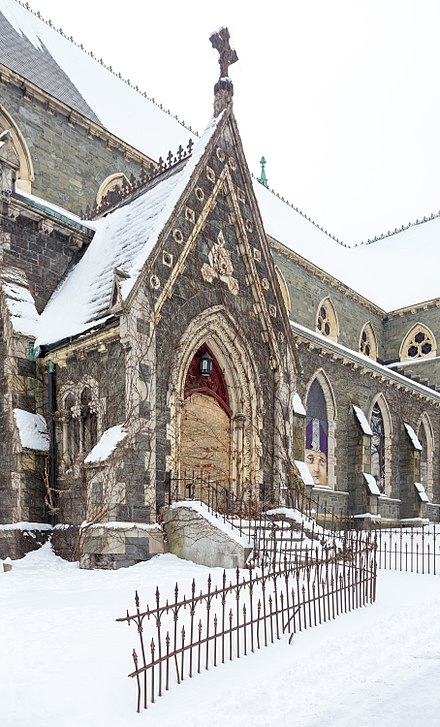You remember Saint Dominic’s, don’t you? It was the fictional big-city parish where Father Chuck O’Malley (Bing Crosby) was sent to help out Father Fitzgibbon (Barry Fitzgerald) in the heart-warming 1944 movie Going My Way.
Lots of parishes like Saint Dominic’s faced financial and social problems in the 1940s and 1950s. But the parish church remained a centre of community and spiritual life until the 1960s — the time of Vatican II — when church attendance and participation in community affairs began their precipitous decline.
The disorientation and disintegration of our society since Vatican II has been much studied. In Coming Apart: The State of White America, 1960-2010, by Charles Murray (New York, 2012), Charles Murray correlates the sickness of our communities with the declining influence of the Church.
Mr Murray studied a neighbourhood like that in which St. Dominic’s might have been located. He called it “Fishtown”, after a real neighbourhood which, together with neighbouring Kensington, forms Zip code 19125 — one of the few remaining white areas in inner-city Philadelphia.
Fishtown has two large churches, St. Anne’s and Holy Name of Jesus. In times past, it was an intensely Catholic neighbourhood. Today, although the quality of their participation in the faith community has changed, the majority of Fishtown’s population still identify as Catholic.
Mr Murray quotes at length from a Ph.D. Dissertation by Patricia Stern Smallacombe. For research purposes, she spent considerable time in a parish she called St. Jude — almost certainly St. Michael’s, in Kensington — in the 1990s.
Ms Smallacombe describes making her way to Mass one Sunday. “I took a shortcut, following other parishioners…. There was a family trudging in front of me — a man, woman and boy. The man and boy were dressed in blue jeans, sneakers, and ‘Eagles’ jackets with hoods, typical attire for most men at mass…. By the time everyone trickled in, there were about a hundred people. Older people and some younger parents in their 20s and 30s genuflected before entering the pews. However, I did not see any children performing this ritual, or saying any prayers for that matter. Most were standing around with their coats on throughout the service; they looked rather blank.”
Is that word picture much different from what you see at your own parish church? How sad! Catholic churches used to be much more than places where people went once a week to worship. They were social centres, as well as places where most of the neighbourhood children were educated. The Catholic worldview pervaded the worldview of parishioners. The Church’s teachings informed and validated the core values of society.
By the time Ms Smallacombe did her research, all that had faded. The religious and social life of the parishes was confined largely to the middle-aged and “senior citizens”, led by even older priests and religious. For the younger generation, the connection with the Church was growing tenuous, even for those who went through the motions.
Even the children who attended the parochial school couldn’t be counted on to carry on Fishtown’s Catholic tradition. “The same children,” Ms Smallacombe wrote, “who appear in Catholic school uniforms and comply with discipline in the school are more likely than their predecessors to be sexually active and drug and alcohol users even before they reach high school; these youths do not acknowledge the consequences of their actions as either morally wrong or potentially dangerous.”
What happened to St. Michael’s, St. Dominic’s and all the other parishes in which Catholics found not just a sense of community but the spiritual nourishment and moral guidance to help them cope with life in an increasingly degraded society?
Vatican II! That’s what! One of the many poisoned fruits of the Council is the hollowing out of our parish churches. The number of faithful who attend Mass is dwindling. See “If the Church were a stock, you’d sell it before it’s too late”, posted here recently. The number who are active in other parish organizations and activities — the Knights of Columbus, Catholic Women’s League, bazaars and the like — is even smaller.
15 years ago, Kenneth C. Jones quantified the decline of the Roman Catholic Church in Index of Leading Catholic Indicators: The Church Since Vatican II. According to esteemed author Patrick Buchanan, the disturbing statistics, prove that “Vatican II appears to have been an unrelieved disaster for Roman Catholicism.”
Mr. Jones’ findings, he continues, “make prophets of Catholic traditionalists who warned that Vatican II would prove a blunder of historic dimensions, and those same findings expose as foolish and naive those who believed a council could reconcile Catholicism and modernity. When Pope John XXIII threw open the windows of the Church, all the poisonous vapors of modernity entered, along with the devil himself.”
Further reading: “Catholicism’s Decline Since the Council”, from the Society of St. John Vianney newsletter.






